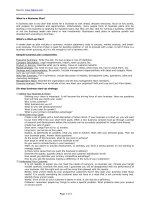Business Plan Templates Projections_1 ppt
Bạn đang xem bản rút gọn của tài liệu. Xem và tải ngay bản đầy đủ của tài liệu tại đây (230.82 KB, 12 trang )
INTRODUCTION
VISION, STRATEGIES & PLANS
TIMESCALES
9
● The vision shapes the strategy,
which in turn shapes the plans
that support it
● The time horizon decreases as
you descend, with plans typically
looking only one year out
● Certainty generally increases as
the time horizon reduces
VISION
STRATEGY
PLANS
10-20+ years
3-5 years
1 year
Vision
Strategy
Support Unit Plans
(HR, Marketing, IT)
A
C
T
I
O
N
S
Business Unit Plans
INTRODUCTION
VISION, STRATEGIES & PLANS
● The vision and strategy are only the pinnacle of the
planning process, with most of the work and
content below them
● The strategy will probably be supported
by several plans within the strategic
context; including business unit
plans and support unit plans,
all of which are linked through
the strategy
● Some plans (HR, marketing,
IT) will cut across the
organisation
● To be of any use, of
course, they must
lead to definite action
10
INTRODUCTION
VISIONS
Many of the most successful organisations can trace their success to the fact that
they have a clear vision which is understood by all employees, customers and,
often, suppliers.
Examples of this include:
John Lewis Partnership
(a UK department store chain) whose motto is ‘Never Knowingly Undersold’
Coca-Cola
(a US soft drink manufacturer) whose vision was originally that US GI’s
should be able to buy a Coke anywhere in the world; currently the
most successful brand in the world
Wedgwood
(a UK china manufacturer) whose philanthropic founder Josiah
Wedgwood had a vision that ordinary people should be
able to buy good crockery at low prices
Microsoft
(a US software company) whose vision is a PC on every desk
11
INTRODUCTION
STRATEGIES
A strategy is the articulation of the vision in terms that can be easily understood by
everyone, although still at a high level.
It takes the vision, which is often on a rather lofty plane, and puts borders around
it in terms of what it means for the company.
This is usually expressed through shared goals with customers and ‘stakeholders’,
as well as goals for excellence.
These are the things at which the organisation
must excel and, therefore, which will shape
the organisation and its internal working
and actions.
12
INTRODUCTION
STRATEGIES
The goals will have a set of measures attached to each to quantify what they mean.
Examples could be:
● Return on assets of 3%
● Cost/income ratios of 45%
● Staff turnover below 5%
● Share price a multiple of 15 times earnings, etc
The goals and measures provide the internal strategic framework within which to plan.
When coupled with the external environment, a series of actions can then be developed
to carry out the strategy - THE PLAN.
13
INTRODUCTION
PLANS
Plans are the tactical means of implementing strategy and achieving objectives.
A plan sets out exactly:
● What needs to be done
● By whom, and
● When
It focuses on the How rather than
the What.
The rest of the book will concentrate
on this aspect.
14
PLANNING THEORY
15
PLANNING THEORY
INTRODUCTION
There is a plethora of writing about planning theory, but there are a few things that
all are agreed on:
● Planning is data driven
● You must have enough information to make decisions, but no more than is
sufficient (avoid paralysis analysis)
● It is more likely that a plan will work if those who have to carry it out are
involved in its conception and development
● It must not be too rigid, but sufficiently flexible to adapt to changing
circumstances
● Progress must be monitored against the plan
16
PLANNING THEORY
WHAT IS A PLAN?
● A plan can be defined as a set of instructions:
- to someone
- to do something
- in a certain manner
- within a given timescale, and
- with a finite set of resources
● It designs and precedes action, but
is not action
● It helps you fit a set of (possibly)
random events into a framework;
this enables you to visualise, and
therefore make sense of, something
intangible and so cope better with it
● It breaks a large undertaking up into
a set of discrete measurable tasks
17
PLANNING THEORY
WHAT IS A PLAN?
A plan:
● Has objectives which can be measured
● Answers questions that stakeholders should be asking
● Builds in options and contingencies
● Identifies and quantifies risks
● Sets out how to minimise those risks or the adverse consequences that
might arise from them
● Allows progress to be measured
Planning involves:
● Management and executive time and input
● Commitment
● Cost
● Research
● Assumptions
Therefore, it is important to get it right (or less wrong than the opposition)!
18
PLANNING THEORY
WHY PLAN?
For some people planning is second nature: for others it is quite the reverse.
The dangers of poor planning will be more obvious in some environments than others.
The greatest military victories were almost always won where they had been planned
thoroughly and all eventualities considered.
Planning gives:
● Certainty
● Measures
● Confidence
● A route map
● Evidence to others of forethought
19
PLANNING THEORY
WHY PLAN?
Planning will help you to:
● Shape your thoughts
● Think through scenarios and implications
● Ensure that points are not missed
● Demonstrate business control
● Identify weaknesses and opportunities
● Examine the risk of an action/set of actions against the return
● Provide a tool to communicate ideas to third parties (superiors, subordinates,
lenders, suppliers, owners, etc)
20









